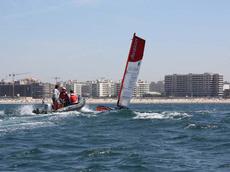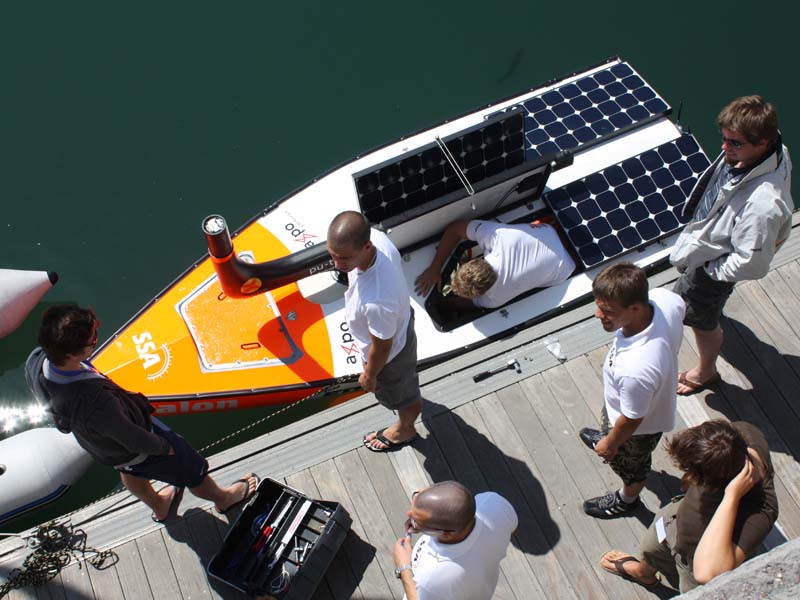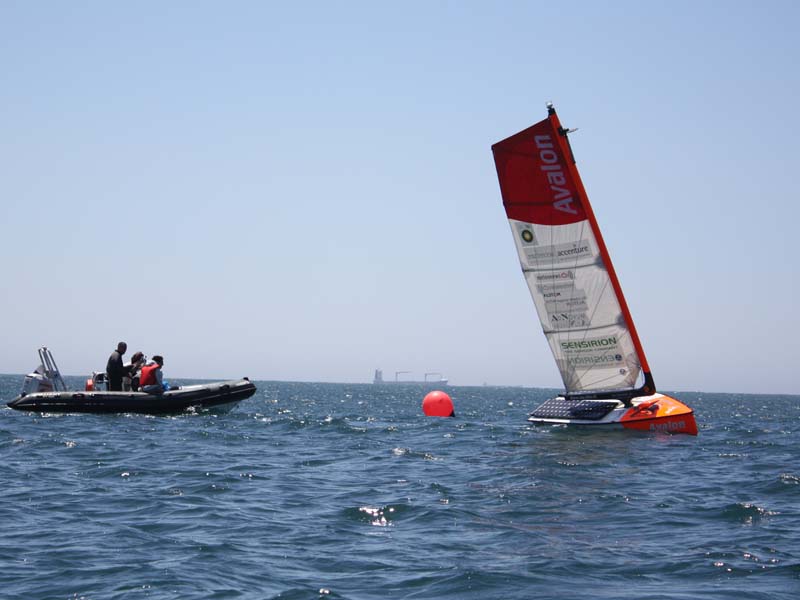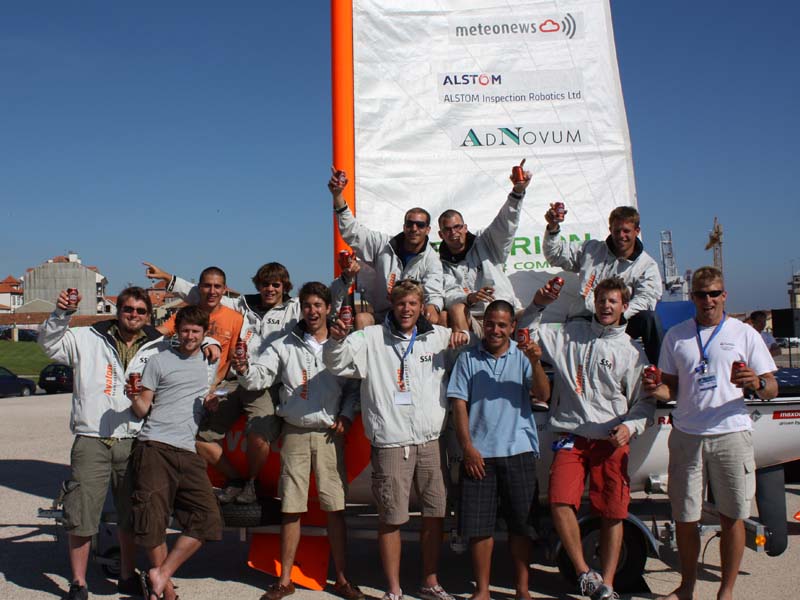Successful dress rehearsal
At the World Robotic Sailing Championship on the Portuguese coast, the ETH team achieved third place with its boat “Avalon”. The Championship was also a test for the major Atlantic crossing planned for September.

You can see the relief on the faces of students Gion-Andri Büsser and Hendrik Erckens. The hard work of the last few months has paid off. At the World Robotic Sailing Championship (http://paginas.fe.up.pt/~jca/wrsc/) in Portugal, the sailing robot “Avalon”, which they developed as part of the focus project, was beaten by just two boats: the Austrian “Roboat” and the Portuguese “FASt”. This was merely down to “minor hitches with the software”.
Otherwise, the two project leaders for the “Student Sailing Automation” group (SSA, http://www.ssa.ethz.ch) are certain that their unmanned sailing boat would have been right at the front of the pack. At four metres long and with a top speed of six knots, it is not only the largest boat in the robotic sailing competition but also the fastest.
The race took place from 6 to 12 July in Portugal, and was not just a quest to crown the world champion. For those boats registered for the International Microtransat Challenge (http://www.microtransat.org/?lang=de) in the autumn, it was also one last major test of resilience: are the boats really technically able to accomplish an Atlantic crossing?
However, the World Championship was a walk in the park compared to the challenge ahead: the longest straight was never more than 300 metres, whereas the competition in the autumn will be over more than 7000 kilometres. The four races on the Portuguese coast still showed the teams where they have to improve and how good the boats sailed in comparison to the competitors.
First test at sea
“The Championship was very helpful and we have learned a lot”, says Gion-Andri Büsser. Not least because the race in Portugal was the first time that the ETH sailing boat had been at sea. Prior to this, the students had only been able to test the boat in lake waters.
The competition showed that Avalon was able to hold a course without any problems on straights, even in very strong winds, but that turning manoeuvres occasionally caused a short loss of orientation. The developers therefore had to switch to remote control every now and again in order to steer the robotic sailing boat to the next buoy. This is not allowed in the competition and led to several point deductions, eventually costing the ETH team the title.
The mechanical engineering students took all of this in their stride, however: “After all, the Austrian team has been working on the software for three years, whereas our group has only had three months”, says Hendrik Erckens. Also, the remote control only had to be used for two seconds to bring Avalon back on course. The SSA group is therefore certain that they will have their software under control by the autumn. Testing will include trials in the Mediterranean. Avalon will be sailing continuous routes of up to 200 nautical miles, from points on the French coast.
The project leaders also claim that the transfer of power from the motor to the sail has not yet been perfected. The transmission needs to be made more robust. However, this is also a minor problem, especially as all other components work without any problems, thanks to generous financial and technical support from active industry representatives. One example of this is a boom constructed especially for Avalon. This is made of carbon fibre and the pivot is not on the mast, as is usually the case with manned vessels, but further back, lowering the energy use. After all, the power supply has to last for two to four months. This is how long organisers are estimating that the transatlantic regatta will take.
Sufficient energy reserves
The eight young engineers have made sure that Avalon will not run out of juice in the middle of the journey by covering the whole deck with solar cells, with a reserve energy source provided by a 28-litre methanol fuel cell on board. “We have calculated that this fuel cell alone could power Avalon for a month.” A continuous power supply is therefore guaranteed.
Gion-Andri Büsser says that there are, however, less predictable risks such as storms that Avalon cannot avoid, or smaller ships on its course. Whilst larger boats transmit positioning data, allowing Avalon to calculate a different route, the ETH sailing boat is relying on smaller ships without this signal to make way.
If you talked to Avalon’s creators, you would think you were listening not only to experienced mechanical engineers but also to hardened worldwide sailors: they talk just as freely about the construction of the individual boat components as they do about the trade wind systems. However, although all of the team members have a little sailing experience, most of the knowledge had to be learned, as Hendrik Erckens admits: “In the beginning, everything was new to us, but the transatlantic competition was a huge motivation.” The eight students therefore asked friends and experts for advice and secured industry sponsors, who now fully finance the ambitious project.
This kind of commitment is exactly what focus projects at ETH need. A product has to be realised from the initial idea through to the final product within a team of students, applying and building on theoretical knowledge gained in their lectures.
World record in sights
“It’s fantastic when you see what this project has become”, reflects Gion-Andri Büsser. Even if it’s a lot more work than just going to lectures. Now all they have to do is cross the Atlantic. This is the ultimate goal – together with a world record. When the robot sailing boats set course for the Caribbean from the Irish coast in the autumn, they will also be heading for an entry in the Guinness Book of Records: never before has an automated sailing boat managed to cross the Atlantic.
Everyone can follow the progress of the eight pioneers’ endeavour, including the Avalon’s route through the waves of the Atlantic, from this autumn using Google Earth and the SSA website. Wish them luck!










READER COMMENTS